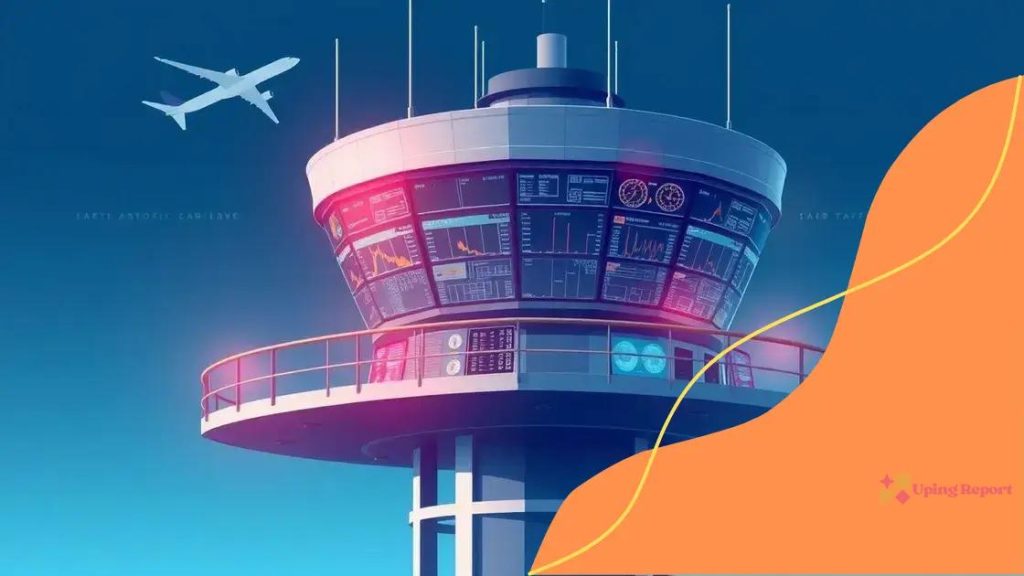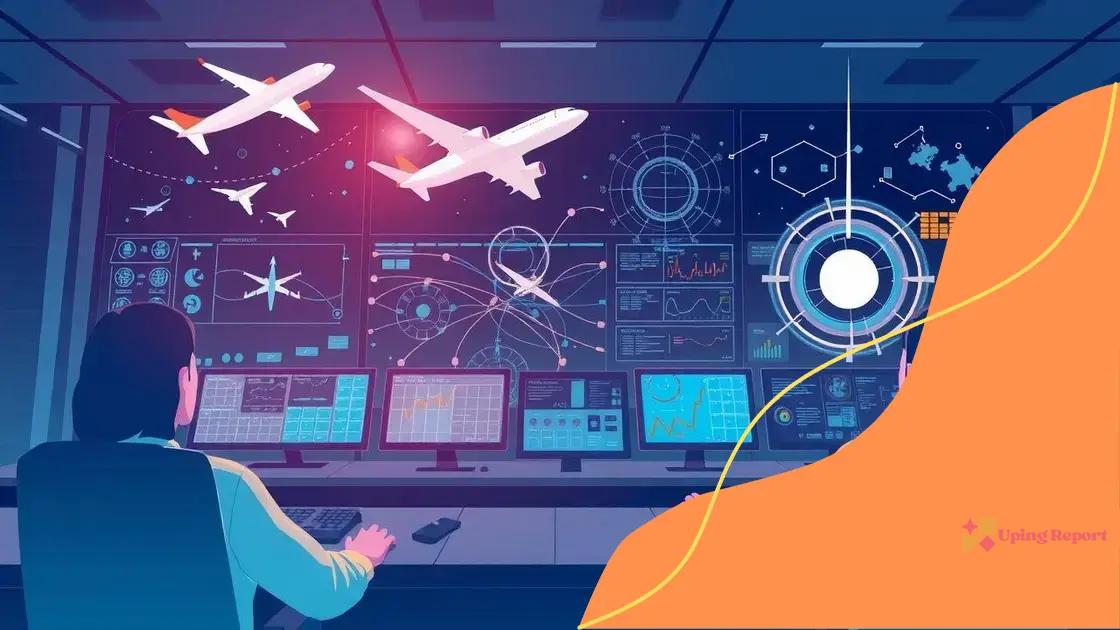Air traffic control system overhaul 2028: what to expect

The air traffic control system overhaul in 2028 aims to enhance safety and efficiency through technological advancements, improved regulations, and better communication, ultimately benefiting airlines and passengers by reducing delays and optimizing flight operations.
Air traffic control system overhaul 2028 promises significant advancements in aviation safety and efficiency. What exactly does this mean for travelers and airlines alike? Let’s dive into the expected changes.
Understanding the current air traffic control system
The current air traffic control system plays a crucial role in ensuring the safety and efficiency of air travel. It manages the movement of aircraft in the skies and on the ground at airports. Understanding how this system operates is essential for recognizing the need for an overhaul.
Components of the Air Traffic Control System
At its core, the air traffic control system consists of several key components that work together seamlessly. These include:
- Air Traffic Control Centers: These facilities oversee large sections of airspace and manage flights using radar and communication systems.
- Control Towers: Located at airports, they manage takeoffs, landings, and ground movements.
- Flight Service Stations: They provide information and services to pilots before and during flights.
- Aeronautical Information Services: These services provide important data about airspace, procedures, and regulations.
An important aspect of the system is its reliance on technology. With tools like radar, GPS, and advanced computer systems, controllers maintain communication with pilots, ensuring safe distances between aircraft.
Challenges in the Current System
Despite its effectiveness, the current air traffic control system faces several challenges. These include:
- Increased air traffic leading to congestion.
- Ageing technology that struggles to keep up with modern demands.
- Operational inefficiencies resulting in delays.
- Cybersecurity threats that could compromise safety.
These challenges highlight the need for a comprehensive overhaul by 2028. By addressing these issues, the new system aims to improve safety and efficiency in air travel.
Key drivers for the overhaul in 2028
The overhaul of the air traffic control system in 2028 is driven by several significant factors that aim to enhance aviation safety and efficiency. Understanding these drivers helps shed light on the necessary changes in the operational landscape of air travel.
Increasing Air Traffic
One major driver is the continuous rise in air traffic worldwide. As more passengers choose air travel, it becomes essential to manage the increasing number of flights effectively. Failure to adjust can lead to congestion in the skies and at airports.
- Inadequate capacity for current flight levels.
- Increasing demand for international travel.
- Need for real-time management of airspace.
This need creates urgency for an overhaul that can accommodate future growth while ensuring safety.
Technological Advancements
Another key factor is the rapid advancement in technology. Innovations such as artificial intelligence and automated systems can streamline air traffic control processes. These technologies offer tools that improve tracking, communication, and overall situational awareness.
Implementing these advancements can:
- Enhance data sharing between aircraft and control centers.
- Reduce the chances of human error.
- Facilitate more efficient routing of flights.
Moreover, upgrading the technological infrastructure will ensure that the system remains reliable and efficient.
Safety and Security Concerns
With the rise in air traffic, safety and security concerns cannot be overlooked. The current system, although effective, needs enhancements to handle emerging threats and challenges. The overhaul aims to bolster safety protocols and integrate new security measures.
By addressing these issues, the new system will mitigate risks associated with air travel, ensuring that passengers and crews are protected.
These drivers present a powerful case for the upcoming changes, paving the way for a more robust and efficient air traffic management system.
Technological advancements in the new system

The technological advancements in the new air traffic control system are set to revolutionize how air traffic is managed. These innovations aim to enhance safety, efficiency, and communication, making air travel smoother for everyone involved.
Automation and Artificial Intelligence
One of the most exciting aspects of the new system is the incorporation of automation and artificial intelligence (AI). These technologies can process vast amounts of data much faster than a human can.
- AI will help predict traffic patterns, allowing for better flight scheduling.
- Automated systems can assist air traffic controllers in real-time decision-making.
- With machine learning, the system can continuously improve its responses to various scenarios.
This shift towards automated systems aims to reduce human error, which is a significant factor in aviation incidents.
Enhanced Communication Tools
Improving communication between pilots and air traffic control is another focus of the overhaul. The current systems often rely on radio communication, which can be susceptible to interference and misunderstandings.
The new system will implement:
- Data link communications, providing clearer messages between pilots and controllers.
- Real-time data sharing that enhances situational awareness for all parties involved.
- Integrated systems that allow seamless communication across various platforms.
By enhancing communication, the new technology aims to reduce the chances of safety incidents caused by miscommunication.
Upgraded Surveillance Systems
Another technological improvement is the advancement in surveillance systems. The implementation of radar systems combined with satellite technology will provide comprehensive coverage of airspace.
This advancement enables:
- More precise tracking of aircraft positions.
- Improved ability to manage congested airspace.
- Greater flexibility in flight routing, reducing delays.
With these technological advancements, the new air traffic control system is prepared to meet the demands of modern air travel.
Potential impacts on airlines and passengers
The potential impacts on airlines and passengers as a result of the air traffic control system overhaul in 2028 are significant and wide-ranging. Understanding these impacts helps both groups prepare for and adapt to the upcoming changes.
Benefits for Airlines
First and foremost, airlines stand to gain from improved efficiency in flight operations. With advanced traffic management systems, airlines can expect:
- Fewer delays due to more accurate scheduling and routing.
- Reduced fuel consumption from optimized flight paths.
- Enhanced safety measures that lower the risk of incidents.
These improvements can lead to cost savings that may be passed on to customers in the form of lower ticket prices.
Passenger Experience Enhancement
Passengers will also notice positive changes. The overhaul aims to create a more seamless travel experience. As air traffic becomes more effectively managed, travelers can look forward to:
- Shorter wait times for takeoff and landing.
- Improved overall safety during flights.
- Better communication from airlines about delays and changes.
This clearer communication helps passengers stay informed and reduces anxiety associated with travel.
Challenges to Consider
While there are many benefits, there are also challenges that may arise during the transition to the new system. Airlines and passengers could face adjustments such as:
- Temporary disruptions as new technologies are integrated.
- The need for airlines to train staff on new systems.
- Adapting to changes in policies and procedures.
By being aware of these potential impacts, both airlines and passengers can better navigate the shift and maximize the advantages that come with the new air traffic control system.
Regulatory changes and challenges ahead
The upcoming regulatory changes associated with the air traffic control system overhaul will significantly impact the aviation industry. As new technologies and procedures are implemented, adjustments in regulations will be necessary to ensure safety and efficiency.
New Safety Regulations
One of the main components of the overhaul will include strengthened safety regulations. These regulations will aim to support the integration of advanced technologies into the current system. Key aspects include:
- Updated training requirements for air traffic controllers to handle new tools.
- Increased safety audits to monitor the effectiveness of the new systems.
- Stricter procedures to manage high traffic volumes safely.
Implementing these new safety regulations will help maintain high safety standards while adapting to the overhaul.
Adapting Existing Policies
Aside from safety measures, existing aviation policies will also need revisions. The goal is to align them with the changes brought about by the new system. This will involve:
- Revising airspace usage policies to accommodate more efficient flight paths.
- Updating reporting requirements for airlines and air traffic facilities.
- Establishing clearer guidelines for data sharing and communication among stakeholders.
These adaptations are crucial for achieving a smooth transition into the new operational framework.
Challenges to Implementation
While regulatory changes aim to improve the system, they also present challenges. Airlines and regulators may encounter difficulties, such as:
- The need for significant investment in training and technology.
- Resistance to change from industry stakeholders.
- Ensuring compliance with new regulations amidst a complicated transition.
Addressing these challenges early on can help mitigate potential issues as the overhaul progresses.
FAQ – Questions About the Air Traffic Control System Overhaul 2028
What are the main goals of the air traffic control system overhaul?
The main goals include improving safety, increasing efficiency, and managing the growing volume of air traffic effectively.
How will technological advancements affect the air traffic control system?
Technological advancements will enhance communication, automate processes, and improve data sharing among various stakeholders.
What impact will these changes have on airlines?
Airlines can expect fewer delays, reduced fuel consumption, and overall improved operational efficiency.
How will passengers benefit from the new system?
Passengers will experience shorter wait times, better communication regarding flight status, and enhanced safety during travel.
